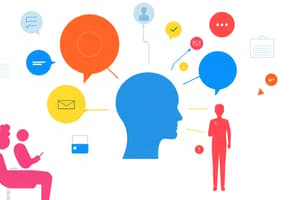Podcast
Questions and Answers
What role does psychology play in understanding human behavior?
What role does psychology play in understanding human behavior?
Psychology involves measuring and explaining the behavior of humans and other animals.
What are the key interpersonal skills that managers should develop for effective leadership?
What are the key interpersonal skills that managers should develop for effective leadership?
Managers should develop communication, empathy, and conflict resolution skills.
How does social psychology differ from traditional psychology?
How does social psychology differ from traditional psychology?
Social psychology combines elements of psychology and sociology to investigate the influence people have on one another.
How does systematic study enhance managerial decision-making?
How does systematic study enhance managerial decision-making?
What does sociology focus on in relation to human behavior?
What does sociology focus on in relation to human behavior?
What challenges exist in understanding organizational behavior (OB)?
What challenges exist in understanding organizational behavior (OB)?
What role does evidence-based management (EBM) play in decision-making?
What role does evidence-based management (EBM) play in decision-making?
Explain how intuition can be integrated with systematic study.
Explain how intuition can be integrated with systematic study.
How do work-life balance priorities affect employee expectations?
How do work-life balance priorities affect employee expectations?
What is positive organizational scholarship?
What is positive organizational scholarship?
What are the limitations of relying solely on intuition in management?
What are the limitations of relying solely on intuition in management?
Identify the disciplines that contribute to the behavioral science of organizational behavior.
Identify the disciplines that contribute to the behavioral science of organizational behavior.
What ethical dilemmas do employees face in the workplace?
What ethical dilemmas do employees face in the workplace?
Why is it important for managers to modify behavioral predictions to reflect individual differences?
Why is it important for managers to modify behavioral predictions to reflect individual differences?
Why is it important to consider contingency variables in organizational behavior?
Why is it important to consider contingency variables in organizational behavior?
How can managers use systematic study to improve their interpersonal skills?
How can managers use systematic study to improve their interpersonal skills?
What is the primary benefit of job enlargement in the workplace?
What is the primary benefit of job enlargement in the workplace?
How do alternative work arrangements benefit employees?
How do alternative work arrangements benefit employees?
What is flexitime and how does it work?
What is flexitime and how does it work?
Why might job sharing be less commonly chosen by employees?
Why might job sharing be less commonly chosen by employees?
What are some advantages of teleworking for employees?
What are some advantages of teleworking for employees?
What is a potential downside of teleworking as mentioned in the content?
What is a potential downside of teleworking as mentioned in the content?
How does job sharing benefit employers?
How does job sharing benefit employers?
What challenge does management face with teleworking?
What challenge does management face with teleworking?
What are the five core dimensions of the job characteristic model?
What are the five core dimensions of the job characteristic model?
How does job rotation affect employee motivation and understanding of their work?
How does job rotation affect employee motivation and understanding of their work?
Define job enrichment and its significance in the workplace.
Define job enrichment and its significance in the workplace.
What is the motivating potential score (MPS) and how is it used?
What is the motivating potential score (MPS) and how is it used?
Explain the concept of task significance in the job characteristic model.
Explain the concept of task significance in the job characteristic model.
What are the potential drawbacks of implementing job rotation?
What are the potential drawbacks of implementing job rotation?
Why is autonomy an important dimension in job design?
Why is autonomy an important dimension in job design?
How does feedback contribute to employee performance in the job characteristic model?
How does feedback contribute to employee performance in the job characteristic model?
What is intuition in the context of decision-making?
What is intuition in the context of decision-making?
Describe overconfidence bias and its common characteristics.
Describe overconfidence bias and its common characteristics.
Explain anchoring bias and how it affects decision-making.
Explain anchoring bias and how it affects decision-making.
What is confirmation bias and how does it influence information gathering?
What is confirmation bias and how does it influence information gathering?
Define availability bias and its impact on decision-making.
Define availability bias and its impact on decision-making.
What does escalation of commitment refer to in decision-making?
What does escalation of commitment refer to in decision-making?
How does randomness error affect decision-making processes?
How does randomness error affect decision-making processes?
Why is it important to balance intuition with rational decision-making?
Why is it important to balance intuition with rational decision-making?
What is one of the main weaknesses of using Action Research in organizational change?
What is one of the main weaknesses of using Action Research in organizational change?
How does Organizational Development (OD) differ in its approach to improving organizations compared to traditional methods?
How does Organizational Development (OD) differ in its approach to improving organizations compared to traditional methods?
What is the primary focus of Appreciative Inquiry in the context of Organizational Development?
What is the primary focus of Appreciative Inquiry in the context of Organizational Development?
Identify one way that OD techniques, such as team building, can be resource-intensive.
Identify one way that OD techniques, such as team building, can be resource-intensive.
What challenge might organizations face when implementing Action Research and OD?
What challenge might organizations face when implementing Action Research and OD?
How does the varied outcome of OD techniques impact their effectiveness?
How does the varied outcome of OD techniques impact their effectiveness?
Why might Lewin’s Model and Kotter’s Plan be less effective in dynamic environments?
Why might Lewin’s Model and Kotter’s Plan be less effective in dynamic environments?
What is one strength of using a holistic approach in Organizational Development?
What is one strength of using a holistic approach in Organizational Development?
Flashcards
Systematic Study
Systematic Study
The process of examining relationships, identifying causes and effects, and drawing conclusions based on scientific evidence.
Evidence-Based Management (EBM)
Evidence-Based Management (EBM)
A management approach that uses scientific evidence to inform managerial decisions, complementing intuition.
Intuition
Intuition
Personal insights, feelings, and hunches about why people behave the way they do.
Overestimating Intuition
Overestimating Intuition
Signup and view all the flashcards
Enhancing Intuition with Systematic Study
Enhancing Intuition with Systematic Study
Signup and view all the flashcards
Organizational Behavior (OB)
Organizational Behavior (OB)
Signup and view all the flashcards
Psychology in OB
Psychology in OB
Signup and view all the flashcards
Social Psychology in OB
Social Psychology in OB
Signup and view all the flashcards
Action Research
Action Research
Signup and view all the flashcards
Organizational Development (OD)
Organizational Development (OD)
Signup and view all the flashcards
Employee Involvement
Employee Involvement
Signup and view all the flashcards
Process Consultation
Process Consultation
Signup and view all the flashcards
Team Building
Team Building
Signup and view all the flashcards
Intergroup Development
Intergroup Development
Signup and view all the flashcards
Appreciative Inquiry
Appreciative Inquiry
Signup and view all the flashcards
Business Intelligence (BI)
Business Intelligence (BI)
Signup and view all the flashcards
Contingency Variables
Contingency Variables
Signup and view all the flashcards
Social Psychology
Social Psychology
Signup and view all the flashcards
Sociology
Sociology
Signup and view all the flashcards
Anthropology
Anthropology
Signup and view all the flashcards
Positive Organizational Scholarship
Positive Organizational Scholarship
Signup and view all the flashcards
Ethical Dilemmas
Ethical Dilemmas
Signup and view all the flashcards
Work-Life Balance Priority
Work-Life Balance Priority
Signup and view all the flashcards
Skill Variety
Skill Variety
Signup and view all the flashcards
Task Identity
Task Identity
Signup and view all the flashcards
Task Significance
Task Significance
Signup and view all the flashcards
Autonomy
Autonomy
Signup and view all the flashcards
Feedback
Feedback
Signup and view all the flashcards
Motivating Potential Score (MPS)
Motivating Potential Score (MPS)
Signup and view all the flashcards
Job Rotation
Job Rotation
Signup and view all the flashcards
Job Enrichment
Job Enrichment
Signup and view all the flashcards
Flexitime
Flexitime
Signup and view all the flashcards
Job Sharing
Job Sharing
Signup and view all the flashcards
Teleworking
Teleworking
Signup and view all the flashcards
Connecting Employees with Beneficiaries
Connecting Employees with Beneficiaries
Signup and view all the flashcards
Alternative Work Arrangements for Diverse Workforce
Alternative Work Arrangements for Diverse Workforce
Signup and view all the flashcards
Teleworking Drawbacks
Teleworking Drawbacks
Signup and view all the flashcards
Job Sharing Benefits for Employers
Job Sharing Benefits for Employers
Signup and view all the flashcards
Decision Making Shortcuts
Decision Making Shortcuts
Signup and view all the flashcards
Overconfidence Bias
Overconfidence Bias
Signup and view all the flashcards
Anchoring Bias
Anchoring Bias
Signup and view all the flashcards
Confirmation Bias
Confirmation Bias
Signup and view all the flashcards
Availability Bias
Availability Bias
Signup and view all the flashcards
Escalation of Commitment
Escalation of Commitment
Signup and view all the flashcards
Randomness Error
Randomness Error
Signup and view all the flashcards
Study Notes
Exam Dates and Information
- EXC3460: Organizational Behavior and Leadership
- EXC34601: Structured test, school exam
- BI Norwegian Business School, Oslo campus
- Exam period: December 13, 2024, 9:00 AM - 12:00 PM
- 7.5 ECTS
Lecture 1 - CH 1 (What is OB?)
- Organizational Behavior (OB) studies how individuals, groups, and structure impact employee behavior to enhance organizational effectiveness.
- Managers need strong interpersonal skills to be effective, as workplaces rated highly correlate with strong interpersonal skills.
- Good interpersonal skills are crucial for success in the workplace.
Lecture 2 - CH 16 (Organizational Culture)
- Organizational culture = shared values, beliefs, and assumptions that guide members' perceptions of the organization.
- Clan Culture: emphasizing collaboration, trust, and support.
- Adhocracy Culture: prioritizing innovation, growth, and autonomy.
- Market Culture: focusing on achievement, competition, and communication.
- Hierarchy Culture: emphasizing stability, routines, and formal structures.
- Strong Culture: unites employees through shared values for higher loyalty, cohesion, and commitment.
- Weak Culture: varying opinions about organizational values, resulting in less alignment.
- Organizational culture is transmitted through stories, rituals, material symbols, and language.
Lecture 3 - CH 7 & 8 (Motivation and Self-Leadership)
- Motivation is the driving force behind an individual's intensity, direction, and persistence toward achieving goals.
- Intensity: the level of effort exerted.
- Direction: the route toward achieving goals.
- Persistence: the duration of effort.
- Content theories (e.g., Maslow's hierarchy of needs, Herzberg's two-factor theory, McClelland's acquired needs theory): focus on the internal factors driving motivation.
- Process theories (e.g., expectancy theory, goal-setting theory): explain how factors interact to motivate individuals.
Lecture 4 - CH 9 & 10 (Group Team Psychology/ Work Climate Issues/ Power & Influences)
- Groups: Two or more people interacting and interdependent, aiming toward shared goals.
- Formal Groups: Defined by the organization's structure and designed to fulfill specific objectives.
- Informal Groups: Formed by people's own needs and are neither formally structured nor organizationally determined.
- Group stages (five-stage model): Forming, Storming, Norming, Performing, and Adjourning.
- Punctuated-equilibrium model: Useful for understanding temporary groups with a finite lifespan.
- Group properties: Roles, norms, status, size, cohesiveness, and group decision-making.
Lecture 5 - CH 5 (Perception, Individual Decision-Making, and Creativity)
- Perception: The process of organizing and interpreting sensory stimuli to understand the environment.
- Attribution theory: Explains how people form perceptions based on whether something is internally or externally caused
- Perception shortcuts: Simplifying strategies, leading to potential errors. (e.g., halo effect, contrast effect, stereotyping)
Lecture 6 - CH 12 (Leadership)
- Leadership: Influences a group toward achieving goals.
- Trait Theories: Focus on identifying specific inherent qualities that differentiate effective leaders from others. (e.g., Big Five Model - conscientiousness, extraversion)
- Behavioral Theories: Describe specific behaviours exhibited by effective leaders (e.g., Initiating structure, consideration)
- Contingency Theories: Leader effectiveness depends on specific situational factors (e.g., Fiedler model, Path-Goal Theory, Hersey and Blanchard's situational theory)
Lecture 7 (Extending previous lectures)
- Types of authority (Weber): Charismatic, Traditional, Legal/rational
- Equity theory: People compare their inputs and outputs and seek balance with relevant others' inputs and outputs.
Lecture 8 (CH 3, 5, & 18)
- Attitudes: Evaluative statements or judgments about objects, people, or events.
- Job Attitudes (e.g., job satisfaction, organizational commitment, employee engagement): Evaluative statements employees make about their work.
- Employee engagement: Willingness and capacity to contribute to organizational success.
Lecture 9 (Technology)
- Technological innovation: Leads to organizational changes in employee requirements, perceptions, and work processes.
- Technological revolutions (e.g., First, Second, Third/First Digital, Second Digital): Major periods of technological advancements altering workplaces and processes.
- Impact on the workplace: How technology affects organizational structures and processes, potentially leading to job displacement
Lecture 10 (Conflicts)
- Conflict: A process where one party perceives that another party has negatively affected, or will negatively affect, something that the first party cares about.
- Causes: Important resources such as political, economic, social, legal and/or ecological factors.
- Types of conflict : (Intra-)group, (inter-)group, dyads, different perspectives.
Conflict resolution approaches (e.g., competing, avoiding, compromising, accommodating, collaborating)
Lecture 11 (Communication)
- Communication: The process of transmitting information and meaning between individuals.
- Communication methods:
- In-person meetings = best for complex issues/emotional feedback
- Phone calls = immediate responses/difficult explanations
- Emails = formal documents/message to many.
- Nonverbal communication: Impacts how messages are interpreted, with behaviors often more credible than words.
- Barriers to communication: Gender, power dynamics, and cultural differences.
- Cross-cultural communication: active listening and effective communication strategies.
WEEK 12 (Diversity & Creativity)
- Diversity in the workplace (surface vs depth): Observable characteristics like gender and ethnicity, vs. deeper characteristics from work preferences to values.
- Creativity: Generating novel and valuable ideas
- Creativity methods.
Studying That Suits You
Use AI to generate personalized quizzes and flashcards to suit your learning preferences.
Related Documents
Description
This quiz explores the intersection of psychology and organizational behavior, highlighting key concepts such as interpersonal skills for managers, evidence-based management, and the role of workplace ethics. Delve into how systematic study enhances decision-making and the impact of work-life balance on employee expectations.



